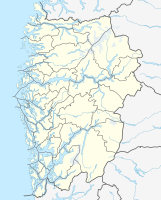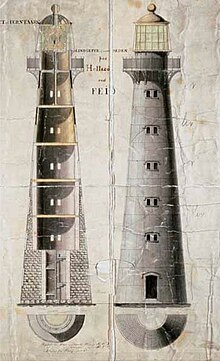Hellisøy fyr
| Hellisøy fyr | ||
|---|---|---|
| Hellisøy fyr as seen from Fedje | ||
| Place: | Fedje | |
| Location: | on the island of Hellisøyna in front of Fedje | |
| Geographical location: | 60 ° 27 '4.7 " N , 4 ° 25' 34.3" E | |
| Height of tower base: | 19 moh. | |
| Fire carrier height : | 32.3 | |
| Fire height : | 46.5 | |
|
|
||
| Identifier : | FFl W 30s | |
| Scope knows: | 18.8 nm (34.8 km ) | |
| Optics: | 3rd order Fresnel lens from 1903 | |
| Operating mode: | electrified 1954, automated 1989, listed since 2000 | |
| Construction time: | 1855 | |
| Operating time: | since 1855 | |
| International ordinal number: | B4134 | |
Hellisøy fyr is a lighthouse in the municipality of Fedje in the Norwegian province of Vestland . After Eigerøy fyr near Egersund, it is the second oldest lighthouse in Norway to be built from cast iron and has been a listed building since 2000.
location
The lighthouse is located on the small island Hellisøyna in the south-east of the island of Fedje and overlooks the northern end of the Hjeltefjord , which meets the North Sea as Fedjeosen . The Hernar archipelago lies on the south side of Fedjeosen . Hellisøyna is separated from the main island by the Fyrsundet and can be reached by a short boat ride. The areas to the west and east of the island are nature reserves. Next to the lighthouse there is the lighthouse keeper's house, a machine house, a boathouse and the foundations of the assistant's apartment on the now uninhabited island. The lighthouse is at the southern end of the island and can be reached by a concrete path.
history
The lighthouse was built in 1855 to mark the entrance to Bergen together with the now demolished Skjeljanger fyr . The cast iron components were supplied by Bærums Verk and Horten Mekaniske Verksted and assembled on site. Then the lighthouse was lined with 35,000 bricks. Up to 95 workers were involved in the construction. First, an old 2nd order lens from Lista fyr was installed, which has been illuminated by a paraffin lamp since 1875. The lighthouse was operated by a lighthouse keeper and an assistant who all lived in the lighthouse keeper's house. In 1902 the lighthouse keeper's house burned down after a lightning strike and was replaced by two separate houses. At the same time, the old lens was removed and replaced by the current 3rd order lens. A meteorological research station was established in 1924. In 1954 the lighthouse was electrified and automated in 1989. However, it was still manned until 1992 when the meteorological station was also automated. Today the lighthouse keeper's house is rented out to overnight guests by the community, which also offers tower tours.
See also
Web links
- Specifications of the lighthouse on the Kystverket website
- Hellisøy fyr website
- Map of the island on Norgeskart
Individual evidence
- ↑ a b c Center for eiendom and culture in samarbeid med Kystverket Vest: Forvaltningsplan for Hellisøy fyrstasjon. (pdf) Kystverket, November 15, 2017, accessed on July 29, 2020 (Norwegian).
- ↑ Per Roger Lauritzen: Hellisøy fyr. Store norske leksikon, June 23, 2020, accessed on July 29, 2020 .
- ↑ a b c Historia om tårnet. Hellisøy fyr, accessed July 29, 2020 .


